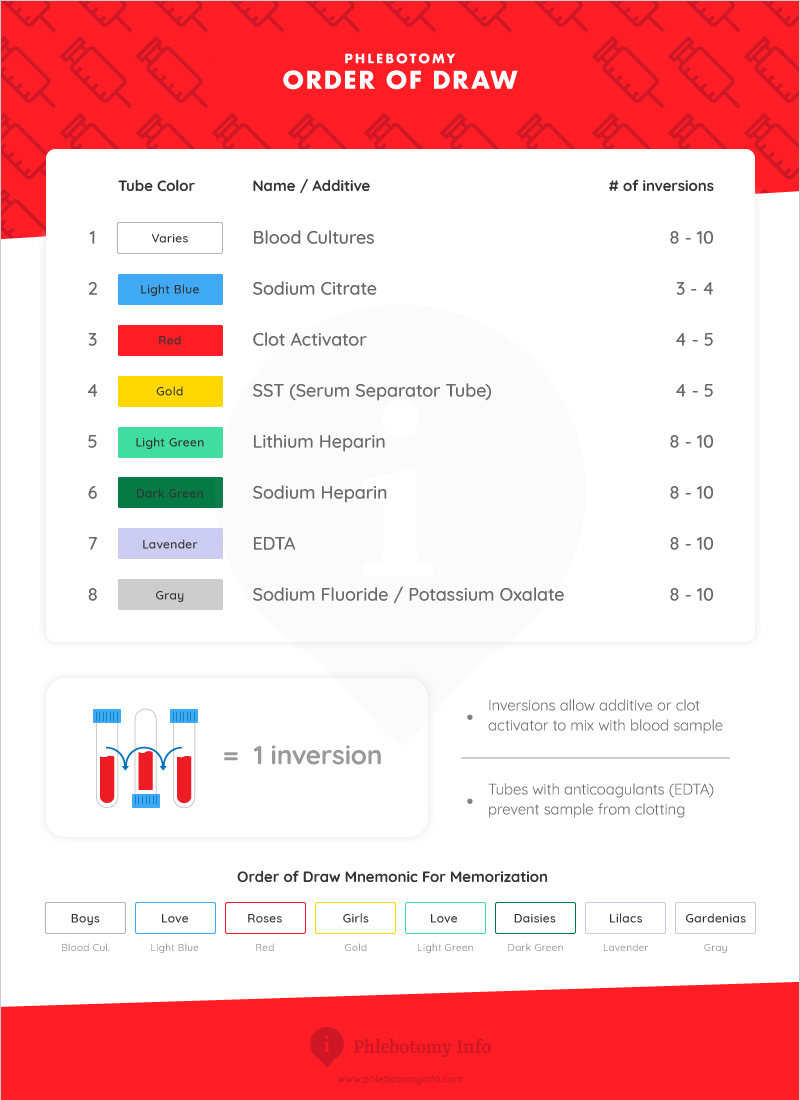Phlebotomists must collect blood samples using collection tubes in a specific order while performing venipuncture on patients to avoid cross-contamination of the various additives between tubes. This process is known as the order of draw.
Unfortunately for entry-level phlebotomists or those in phlebotomy training, this process can be quite confusing and often difficult to remember.
Order of Draw Table
Due to the many colored-top blood collection tubes, it can often be difficult to remember the correct order. Luckily we’ve composed a simple chart, mnemonic, and infographic to easily help phlebotomists remember the proper order.
By using the following mnemonic you’ll have an easier time remembering the proper order:
Boys Love Roses; Girls Love Daisies, Lilacs, and Gardenias.
This mnemonic is simply one we’ve provided, and can be altered to anything that will help you memorize it easier.
| Blood Draw Order | Tube Color | Name/Additive | # of Inversions |
|---|---|---|---|
| 1 | Varies | Blood Cultures | 8 – 10 |
| 2 | Light Blue | Sodium Citrate | 3 – 4 |
| 3 | Red | Clot Activator | 4 – 5 |
| 4 | Gold | SST (Serum Separator Tube) | 4 – 5 |
| 5 | Light Green | Lithium Heparin | 8 – 10 |
| 6 | Dark Green | Sodium Heparin | 8 – 10 |
| 7 | Lavender | EDTA | 8 – 10 |
| 8 | Gray | Sodium Fluoride / Potassium Oxalate | 8 – 10 |
Why is the Order of Draw Important?
Remembering the proper order during a venipuncture procedure on a patient is important for a few reasons:
- Decrease the time it takes to perform the procedure
- Reduce patient discomfort
- Avoid complications for patient
- Prevent misdiagnosis of patient
- Prevent cross-contamination of additives between blood collection tubes
As a result of applying the proper order of collection tubes, you’re providing a safer, more comfortable experience for your patient, which is always the number one priority when drawing blood. Above all, this also ensures that the patient’s results will come back accurate and result in proper diagnosis and treatment.
What are Inversions?
A phlebotomist inverts each blood sample by rotating the tube vertically by 180 degrees. The infographic below displays what constitutes as one full inversion.
These inversions are necessary to mix the blood specimen with each tube’s additive to ensure that there is no cross-contamination between tubes.
Therefore, cross-contamination of the additives might result in misdiagnosis or mistreatment of the patient.


Wow best site ever,well explained keep it up.
thanks, useful info
I have been looking for a simple draw order for months now and I have finally found it thank you
Thank you so much wonderful information.